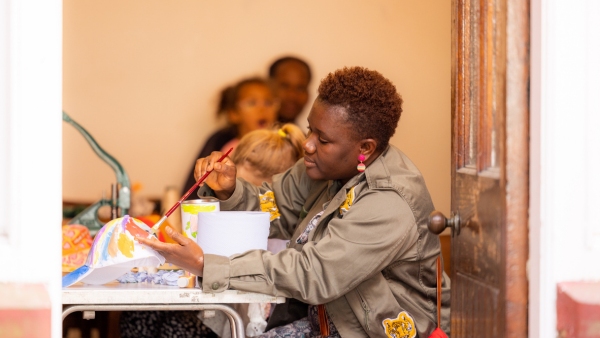As Easter approaches perhaps I can be allowed to be even more self-indulgent than usual? I am using today’s post to give vent to a deep frustration and to issue a challenge.
As Easter approaches perhaps I can be allowed to be even more self-indulgent than usual? I am using today’s post to give vent to a deep frustration and to issue a challenge.
When it comes to the Big Society, kids’ football is an amazing success story. I don’t have the figures to hand (if anyone does, please comment) but I think I recall that on any given weekend more than a million parents are involved in in some way: coaching, organising, giving lifts or just being there to cheer on their offspring. This is in support of an activity which is unambiguously beneficial: improving children’s health, developing their capacity to work in teams, to understand the difference between healthy competition and unacceptable aggression, and to handle success and failure.
Best of all, and again I wish I had the stats to hand, volunteering for kids’ football is not nearly as socially stratified as most other forms of civic engagement; working class and ethnic minority kids and parents are just as likely to get involved.
But there is cloud hanging over the park pitches of England. As austerity bites and as the costs of football rise (kits, pitch fees, ref’s fees, the burden of regulation) many clubs are finding it difficult to survive. Here is one example which has made the news: Senrab– the team which helped develop the skills of John Terry and Sol Campbell – is apparently under threat. Given its famous links and the publicity it has received, Senrab will probably survive but every week many other clubs fold as exhausted enthusiasts give up the ghost.
The big issue here is the amount of money flowing down to community football, and I would be keen to hear from anyone who can comment on that overall picture. But I want to focus on something more specific. One of the problems for tens of thousands of kids’ clubs is not only the cost but the quality of the pitches on which they have to play. After the winter we have had, and now a long dry spell, pitches combine an uneven surface with a high and erratic bounce. It’s like trying to play snooker on corrugated metal. People who don’t play football might think this is all part of the challenge – after all both sides have to cope with a bad pitch and isn’t adjusting part of being a good footballer?
Well, not really. Of course, players have to adapt, especially to different weather conditions. But becoming a skilful player is a lot to do with developing an intuitive ability to judge a pass, predict a bounce and look up from the ball to see options. If the pitch is terrible, it is impossible to develop these skills; good players get demoralised and effectiveness comes down to size and determination rather than skill and intelligence. This is not just bad for the skilful players who get demoralised but for the ones who succeed due to sheer strength only to be exposed if and when they try to play at a higher level. The other problem with standard grass pitches is that they are often simply unplayable. This year my own son’s team played about three games between November and February.
We urgently need thousands more high quality artificial grass pitches. They are always playable and can be played on back to back. Because they can always be used it becomes more economical to install cheap portable floodlights to provide longer playing days in the winter. A collegue here at the RSA contrasts his local town which has four pitches which are all pretty poor and often unplayable with the town in Germany where his girlfriend lives. The German town has a single shared artificial pitch which is played on for ten or eleven hours a day all weekend (and also on some evenings). The one German pitch is not only better but, over the year, provides as much playing time as the four English ones.
The technology of artificial pitches is improving all the time. I met earlier this week with the inspirational CEO of a company called Desso. Pitches are 20% of their business and they are also committed to a cradle to cradle manufacturing process which means pitches get fully recycled when they have reached the end of their lives.
The problem – as it seems to be on so many issues nowadays - is finance. Few, if any, clubs – even if they muck in together - can afford the upfront cost of a pitch. Most pitches wouldn’t anyway be owned by one club, they would need to be managed by a trust which would then cover its costs by hiring fees. The clubs or trust would need a deal whereby they can either lease a pitch or buy it over several years. The risk should be manageable because even if a club goes bust the pitch can be leased or sold on to someone else.
So what we need is easy. An alliance between a bank which is willing to develop a finance package which is simple, and affordable, a supplier of pitches willing to offer a good deal to clubs including support and maintenance (with great sustainability credentials) – judging by the enthusiasm of the CEO, Desso could be such a company, and the FA which would administer the scheme and provide clubs with upfront costs and advice. How about a target of 5,000 more artificial community use pitches by 2015?
As if often the case, this blog is strong on passion but weak on research (comes of being a busy CEO with a butterfly mind). So, there may be an obvious problems with my idea or it might be that there is already some scheme out there just like this. But unless we can enable our youngsters to play football on better surfaces then most of them will not learn the beautiful game but instead – at best - become proficient at kick and run.
Related articles
-
Open RSA knowledge standards
Alessandra Tombazzi Tom Kenyon
After investigating ‘knowledge commons’, we're introducing our open RSA standards and what they mean for our practice, products and processes.
-
RSA Catalyst Awards 2023: winners announced
Alexandra Brown
Learn about the 11 exciting innovation projects receiving RSA Catalyst funding in our 2023 awards.
-
Investment for inclusive and sustainable growth in cities
Anna Valero
Anna Valero highlights a decisive decade for addressing the UK’s longstanding productivity problems, large and persistent inequalities across and within regions, and delivering on net zero commitments.




Be the first to write a comment
Comments
Please login to post a comment or reply
Don't have an account? Click here to register.